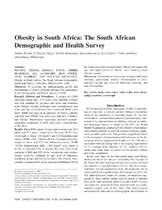| dc.description.abstract | To ascertain the anthropometric profile and determinants of obesity in South Africans who participated in the Demographic and Health Survey in 1998.
RESEARCH METHODS AND PROCEDURES: A sample of 13,089 men and women (age, _15 years) were randomly selected and then stratified by province and urban and nonurban areas. Height, weight, mid-upper arm circumference, and waist and hip circumference were measured. Body mass index (BMI) was used as an indicator of obesity, and the waist/hip ratio (WHR) was used as an indicator of abdominal obesity. Multivariate regression identified sociodemographic predictors of BMI and waist circumference in the data.
RESULTS: Mean BMI values for men and women were 22.9 kg/m2 and 27.1 kg/m2, respectively. For men, 29.2% were overweight or obese (_25 kg/m2) and 9.2% had abdominal obesity (WHR _1.0), whereas 56.6% of women were overweight or obese and 42% had abdominal obesity (WHR _0.85). Underweight (BMI _18.5 kg/m2) was found in 12.2% of men and 5.6% of women. For men, 19% of the variation of BMI and 34% of the variation in waist circumference could be explained by age, level of education, population group, and area of residence. For women, these variables explained 16% of the variation of BMI and 24% of the variation in waist circumference. Obesity increased with age, and higher levels of obesity were found in urban African women.
DISCUSSION: Overnutrition is prevalent among adult South Africans, particularly women. Determinants of overnutrition include age, level of education, ethnicity, and area of residence. | en_US |

